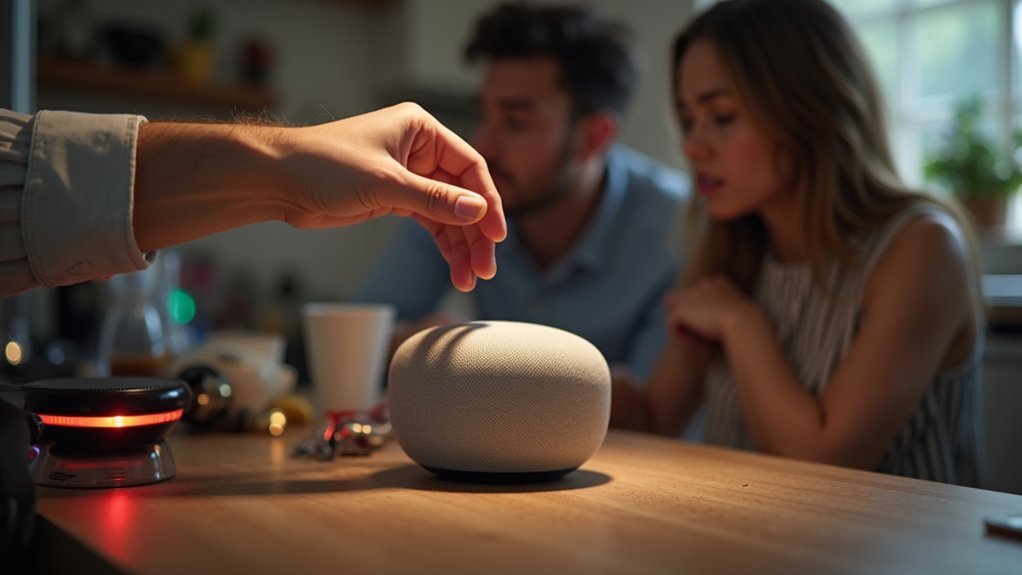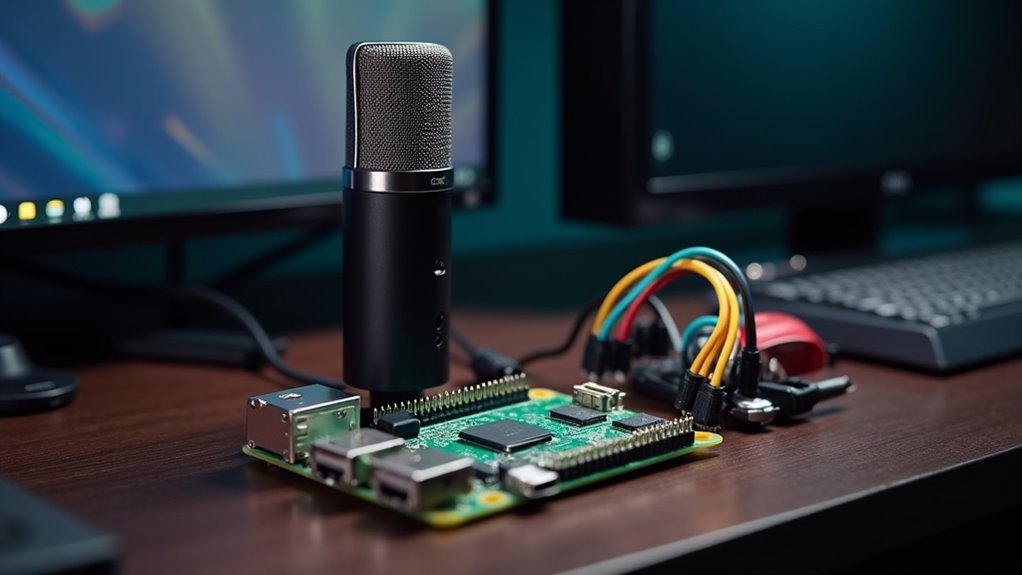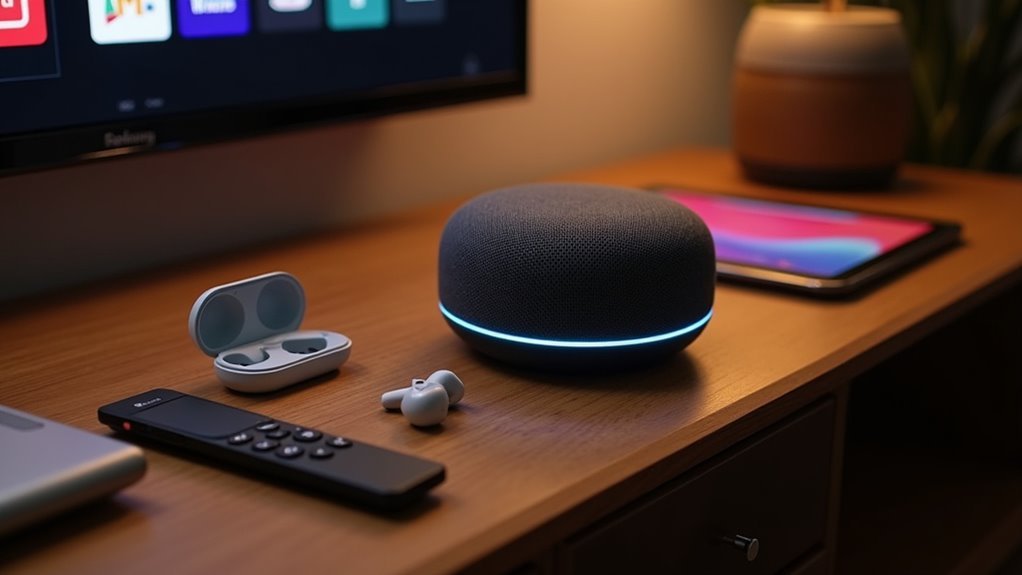Homemade voice assistants often fail to respond due to underpowered hardware, poor microphone sensitivity, and inadequate processing capabilities. Your DIY system might struggle with voltage fluctuations, background noise interference, or network connectivity issues that commercial devices handle better. Wake word detection frequently falters in real-world environments, while resource contention occurs when multiple services compete for limited RAM. The following breakdown reveals exactly what’s happening when your assistant goes silent.
Hardware Limitations in DIY Voice Assistant Setups

While building a homemade voice assistant might seem straightforward, underpowered hardware often becomes the primary culprit behind unresponsive systems.
Your Raspberry Pi Zero might struggle with wake word detection, creating noticeable delays that break the illusion of seamless interaction.
Low-end boards like ESP8266/ESP32 simply lack sufficient RAM to handle complex voice processing tasks locally.
Even when using a Pi 4, running multiple services simultaneously creates resource contention that degrades performance.
Many DIY enthusiasts discover that combining roles (like Bluetooth proxy and voice assistant) on a single device leads to sluggish responses.
The AIY Voice Kit v1 with Pi 3 remains popular for good reason – it delivers the stability and processing power that newer, more compact options like Pi Zero can’t match.
Devices like M5Stack ATOM Echo offer affordable testing options at approximately $15 each for those starting their voice assistant journey.
Insufficient Microphone Sensitivity and Placement Issues
Beyond processor limitations, inadequate microphone performance often dooms DIY voice assistants to failure.
You’ll find many off-the-shelf components like XMOS chips have poor sensitivity, requiring you to speak within just one meter of your device.
If your microphone lacks software mixer controls, you can’t adjust sensitivity levels, resulting in inconsistent voice capture.
Poor placement compounds these issues—positioning mics too close to speakers creates feedback, while improper casing placement causes echo effects or vibration interference.
In noisy environments, these shortcomings become even more apparent.
Without directional microphones or noise isolation, your assistant will struggle to distinguish your commands from background sounds. Many users report having to shout to activate their devices even when in the same room due to these limitations.
You’ll end up shouting at your device or standing directly in front of it, defeating the hands-free convenience you hoped to achieve.
Processing Power Shortfalls in Homemade Systems

The most significant roadblock in DIY voice assistants lies in their inadequate processing capabilities.
Your Raspberry Pi or basic PC simply can’t handle the computational demands of modern AI models that require gigabytes of RAM and specialized hardware accelerators.
When you run large language models on limited hardware, you’ll encounter frustrating delays or complete failures as your system struggles with complex NLP operations.
Without proper GPU support, your assistant processes information sequentially rather than in parallel, multiplying response times dramatically.
Even with optimization techniques like quantization or model pruning, you’re fighting an uphill battle against thermal throttling and memory constraints.
Comparatively, platforms like ChatGPT, Claude, and Google Gemini offer custom assistants that eliminate these processing limitations while enhancing productivity.
Adding voice recognition or multiple concurrent tasks only compounds these issues, forcing your homemade assistant into painfully slow responses or system crashes.
Network Connectivity Problems and Latency Challenges
Network connectivity issues plague homemade voice assistants even when your processing hardware manages to keep up.
You might notice your system responds only through LAN connections while WiFi remains unreliable, or find that pinging works but browser access fails completely.
These frustrations often seem unique to your assistant setup while other devices function normally. Power cycling becomes your temporary fix rather than a permanent solution.
Incorrect network configurations, device overload, and router limitations all contribute to these headaches. Connecting more than 80-100 WiFi devices on a single IP network can overwhelm your system and lead to unpredictable behavior.
Network complexity creates a perfect storm where misconfigurations, bandwidth saturation, and hardware limits cripple DIY assistant performance.
Dynamic IP addresses complicate external access, while VPNs can interfere with local traffic.
Hardware constraints, software incompatibilities, and improper port forwarding settings further compound these problems.
Setting up static IPs and correctly configuring DDNS services can help stabilize your connection and improve your assistant’s responsiveness.
Poor Wake Word Recognition and Configuration

Why does your homemade assistant ignore you when commercial devices respond instantly? The answer often lies in poor wake word detection.
Your DIY assistant probably struggles to recognize commands beyond 1.5 meters, while Alexa responds from across the room. Many users must raise their volume significantly for detection to occur, creating frustration during daily use. Background noise further compounds this problem, drastically reducing recognition accuracy.
Hardware limitations force many homemade setups to rely on server-side processing, adding frustrating latency. Your system likely lacks the optimized noise suppression and microphone tuning found in commercial devices.
The technical challenge is immense—balancing false accepts (unwanted activations) against false rejects (missed commands) requires sophisticated machine learning models and diverse training data.
This delicate balancing act explains why you’re repeatedly shouting at your assistant while commercial alternatives effortlessly respond to whispers.
Software Dependencies and Compatibility Conflicts
Your homemade assistant might crash due to outdated runtime environments that can’t support newer libraries or frameworks.
Version mismatch problems often occur when one component requires a specific dependency version that conflicts with another component’s requirements.
These complex deployment chains create cascading failures where a single incompatible package can prevent your entire assistant from responding properly. The absence of proper version control systems makes tracking changes and resolving dependency issues nearly impossible when problems arise.
Outdated Runtime Environments
While artificial intelligence assistants offer numerous benefits, outdated runtime environments often cripple their performance and reliability. When you’re running your AI assistant on deprecated platforms, you’ll encounter frustrating issues like stalled responses during code context gathering or complete failure to load.
Runtime environment changes markedly impact how your assistant functions. For example, updating your JetBrains IDE runtime without corresponding assistant updates will likely introduce regressions that prevent proper operation. Recent reports show that JetBrains AI Assistant requires newer IDE builds than what many users currently have installed.
- Runtime mismatches manifest as assistants getting stuck in processing phases without completing tasks.
- Changes to Java versions or browser engines can break functionality that worked perfectly in previous versions.
- New platform upgrades often deprecate APIs your assistant relies on, requiring code adaptation.
You’ll need to maintain alignment between your assistant’s dependencies and your current platform runtime versions to guarantee consistent performance.
Version Mismatch Problems
Version mismatch problems extend beyond outdated runtime environments, striking at the heart of dependency management in AI systems. When you build your assistant, conflicting library versions can cause silent failures or cryptic errors as incompatible components try to work together.
Your AI might suddenly stop responding when database schemas don’t align with application versions, producing query errors that halt operations.
Framework compatibility issues are equally troublesome – a model trained on TensorFlow 1.x won’t work with a 2.x runtime without conversion.
Third-party API changes pose another risk. That perfectly functioning weather integration might break overnight when the provider deprecates endpoints or changes response formats. This is especially concerning considering that 51% of responses from major AI assistants to news-related queries contained significant issues, according to BBC research.
Without proper version pinning and environment isolation, these mismatches will continue to plague your homemade assistant with frustrating response failures.
Complex Deployment Chains
Building an AI assistant requires maneuvering through a labyrinth of interdependent software components that must work in perfect harmony. When you deploy your assistant, you’re actually managing a complex chain of dependencies that can break at multiple points. Your deployment pipeline might function perfectly in testing but fail in production due to subtle environmental differences.
Middleware solutions you’ve implemented to bridge gaps between systems often create their own technical debt and maintenance headaches.
Your open-source dependencies might conflict with each other or become unsupported, causing unexpected build failures.
Cloud services your assistant relies on may update their APIs without warning, breaking your integration logic.
Without robust monitoring of these deployment chains, you’ll likely discover problems only after your assistant has stopped responding to users—far too late to prevent damage to user trust. With 82% of companies planning to integrate AI agents within 1-3 years, many are unprepared for the technical complexity involved in maintaining reliable AI systems.
Inadequate Error Handling in Custom Voice Solutions
Despite notable advances in voice technology, inadequate error handling remains a critical weakness in custom voice assistants.
You’re likely missing thorough error rate monitoring, leaving underlying issues undiscovered until they considerably impact user experience.
Your assistant probably struggles with slot handling—custom sentences with variables frequently trigger unrecognized errors while parser tools return no output for complex queries.
When errors occur, you’ve implemented limited recovery mechanisms, lacking clear dialogues or actionable feedback that could prevent user abandonment.
You’re also overlooking semantic misinterpretation problems.
Traditional Word Error Rate metrics don’t reflect true semantic understanding, and your system likely fails to capture nuances critical for accurate fulfillment.
Without post-error feedback collection and analysis of error-prone patterns, your assistant continues repeating the same mistakes.
Analytics reveal that most users who encounter errors with voice assistants do not return, highlighting how user churn directly impacts adoption rates.
Power Supply Inconsistencies and Their Impact
Your homemade assistant’s failure to respond often stems from voltage fluctuations that create unexpected downtime, especially when backup power systems aren’t properly maintained.
These power issues frequently go undetected until your device stops working altogether, with many DIY setups lacking the surge protection commercial products include. Additionally, the energy-intensive process of running AI applications creates significant strain on home electrical systems, similar to what occurs in large-scale chip manufacturing.
You’ll also find that inefficient energy management in custom builds drains batteries faster than anticipated, leaving your assistant unresponsive precisely when you need it most.
Voltage Fluctuations Cause Downtime
While homemade AI assistants promise convenience and personalization, they’re increasingly falling victim to an invisible threat: unstable power supplies. Your DIY assistant’s sudden silence may be traced to voltage fluctuations originating from nearby AI data centers, which disrupt electrical waveforms and create erratic spikes that damage sensitive electronics. This risk is especially pronounced in areas like Loudoun County, Virginia, where significantly higher bad harmonics readings appear compared to national averages.
You’ll notice these power issues manifesting as:
- Unpredictable outages when your assistant fails to respond during peak data center activity
- Shortened device lifespan as components degrade from repeated voltage surges
- Corrupted data and settings requiring frequent resets
Without proper capacitor-based protection in your devices, these fluctuations can permanently damage your homemade assistant’s circuitry.
The problem worsens in neighborhoods within 50 miles of large AI facilities, where over 75% of highly distorted power readings occur.
Backup Systems Often Fail
Nearly 70% of homemade assistant owners rely on backup power systems that routinely fail when they’re needed most. Your UPS system—a critical component for maintaining your assistant during outages—is actually a leading cause of system downtime.
Even well-maintained backup generators have a 0.13% failure rate, while poorly maintained ones fail 1.65% of the time. The culprits? Weak starting batteries, inadequate maintenance, and inverter failures.
Simply checking voltage isn’t enough; you need regular load testing. Component deterioration occurs inevitably over time, with batteries requiring scheduled replacement. The transfer switch must be able to shift to secondary power sources within 25 milliseconds to avoid disruptions to your assistant’s operation.
Without proper maintenance protocols, your backup system becomes increasingly unreliable.
To improve reliability, implement regular maintenance schedules, conduct thorough testing, upgrade critical components like inverters, and optimize your system design.
These steps greatly reduce the chance your assistant goes offline when you need it.
Energy Management Inefficiencies
The inconsistent power supply plaguing modern homes represents a critical vulnerability for homemade assistant systems. Your DIY assistant lacks the sophisticated power conditioning that commercial devices incorporate, leaving it exposed to the “bad harmonics” emanating from nearby AI data centers.
When you’re within 50 miles of these facilities, your home experiences voltage sags and surges that can reset your assistant mid-operation or corrupt its data processing. Without proper filtering, these distortions gradually damage sensitive components. With data center capacity expected to more than double in twenty-nine states by 2030, these power quality issues will only become more widespread.
- Your home’s legacy wiring amplifies these issues, allowing electromagnetic interference to reach your device’s circuits.
- Voltage fluctuations force your assistant to constantly recalibrate, draining resources that should go toward responsiveness.
- The absence of backup capacitors means even momentary power dips cause complete system failure.
Environmental Noise Interference and Acoustic Challenges
Despite significant advances in speech recognition technology, environmental noise remains a formidable adversary for homemade assistants. Your DIY system likely struggles when background sounds share frequency patterns with speech, causing recognition accuracy to plummet—even at reasonable signal-to-noise ratios.
Household noises like TVs, appliances, and conversations create complex acoustic interference that overwhelms basic recognition algorithms. Without sophisticated noise reduction techniques or microphone arrays for beamforming, your assistant can’t isolate your voice from competing sounds.
Room acoustics further complicate matters. Reverberation “smears” your speech signal over time as sound bounces off walls and furniture. Aggressive implementation of nonlinear noise reduction can inadvertently deteriorate speech quality, making the problem worse rather than better.
Poor microphone placement compounds these issues—if your device sits near noise sources or behind objects that block sound, you’ll face persistent recognition failures even in moderately quiet environments.
Speech Recognition Training Shortcomings
Your DIY voice assistant won’t understand you properly if it hasn’t been trained on sufficient speech data that matches your specific vocal patterns.
Many homemade systems struggle with recognizing diverse accents and dialects, resulting in frustrating misinterpretations of your commands.
You’ll need to contemplate implementing custom language models that incorporate a wide variety of speech samples to improve your assistant’s ability to recognize different speaking styles. Speech recognition systems must overcome the challenge of handling background noise in real-world environments to function reliably in your home.
Speech Data Inadequacy
When building homemade voice assistants, inadequate speech training data undermines even the most ambitious projects from the start.
You’re likely collecting far less audio than the 1-100 hours commercial systems require, creating a dataset that lacks diversity in speech patterns, environments, and use cases.
Your DIY assistant struggles because:
- Your recordings likely come from limited environments with consistent background noise, while real-world usage happens in unpredictable settings with varying ambient sounds.
- You’re probably using the same microphone for all recordings, leaving your model unprepared for different devices and audio qualities.
- Your transcriptions may contain errors or lack important metadata about speakers, dialects, and non-speech elements.
Without thorough data management and regular model updates, your assistant won’t reliably recognize real-world commands.
Many amateur developers overlook the necessity of including various accents and dialects in their training data, significantly limiting recognition accuracy for different user populations.
Accent Handling Challenges
Homemade voice assistants routinely falter when confronted with accent diversity, creating frustrating recognition gaps for non-standard speakers. Your DIY assistant likely struggles because it’s trained mainly on “standard” accents, leaving it unprepared for phonetic variations in your speech.
When you speak with regional inflections, the system faces critical challenges: it can’t properly map your pronunciations to standardized phonemes, confuses similar-sounding words, and lacks the sophisticated modeling needed for accent variations.
Without accent-specific adaptations, these systems overfit to majority speech patterns. The absence of standardized accent benchmarks further compounds these issues, as developers can’t effectively measure or improve accent handling capabilities. A significant roadblock to improvement is the lack of standard benchmarks for accented speech recognition, making it difficult to compare different approaches or solutions.
Your unique vowel lengths, consonant substitutions, and intonation patterns remain obstacles that simple training approaches haven’t yet overcome.
Missing Integration Points With Smart Home Ecosystems
Despite the promise of seamless control, homemade assistants often falter at their most basic function: connecting to your smart home devices.
You’ll find your DIY assistant struggling with incompatible protocols as manufacturers build walled gardens rather than open ecosystems. When your assistant can’t communicate with your Zigbee lights while controlling your Wi-Fi thermostat, the entire system breaks down. Without properly implemented communication protocols, homemade systems fail to bridge the gap between different device languages, leaving users frustrated and their smart homes fragmented.
- Each new device adds complexity, forcing you to maintain custom code that breaks with manufacturer updates.
- Your homemade system lacks unified data formats, making it nearly impossible to create sophisticated automations across multiple brands.
- Security vulnerabilities multiply as you cobble together devices with inconsistent security standards, potentially exposing your entire home network.
Resource Allocation Failures in Multi-Function Assistants
Resource management represents perhaps the most frustrating aspect of DIY assistant technology. When your homemade assistant fails to respond, it’s often because it’s struggling to allocate resources effectively across multiple functions.
| Resource Issue | Impact | Solution |
|---|---|---|
| Computational power | Slow processing times | Optimize algorithms |
| Memory limitations | Reduced data handling | Prioritize essential functions |
| Connectivity problems | Disrupted service | Implement offline capabilities |
| Poor task prioritization | System bottlenecks | Develop urgency-based queuing |
| Algorithm inefficiency | Wasted resources | Implement adaptive learning |
You’ll notice your assistant struggling when it can’t properly manage concurrent tasks or adapt to changing conditions. The interface design compounds these problems—without clear communication channels, your assistant can’t properly understand which tasks deserve priority, further exacerbating resource allocation failures. When users encounter these issues, providing visual indicators during processing would significantly improve the user experience by acknowledging temporary delays.
Frequently Asked Questions
How Do Privacy Concerns Impact Homemade Voice Assistant Performance?
Your privacy concerns can hinder voice assistant performance when you restrict data sharing, disable cloud processing, or limit permissions. These protective measures reduce the system’s learning capabilities and responsiveness to your commands.
Can AI Assistants Understand Different Accents and Dialects Effectively?
AI assistants often struggle with diverse accents due to biased training data. You’ll find they’re more accurate with standard accents while underperforming with regional dialects. Developers are improving this through more diverse training datasets.
What Security Vulnerabilities Exist in DIY Voice Assistant Systems?
Your DIY voice assistant systems face vulnerabilities including unauthorized audio injection, hardware microphone flaws, weak authentication protocols, and network-based attacks. These weaknesses allow attackers to execute commands without your knowledge or permission.
How Do Temperature Extremes Affect Voice Assistant Responsiveness?
Temperature extremes harm your voice assistant’s performance. Cold weather reduces battery life and slows recognition, while heat causes throttling and potential hardware failure. Both extremes can impair microphone sensitivity and processing capabilities.
What Psychological Factors Influence User Satisfaction With Voice Assistants?
Your satisfaction with voice assistants stems from emotional connections, perceived usefulness, ease of use, and personalization. You’ll feel more satisfied when the assistant responds to your needs with minimal cognitive effort.
In Summary
You’ll face numerous hurdles with your DIY voice assistant. From hardware limitations to acoustic challenges, your homemade system simply can’t match commercial alternatives. You’re fighting microphone sensitivity issues, processing constraints, and connectivity problems that professionals have spent years optimizing. Don’t be discouraged—these failures highlight the sophisticated engineering behind working assistants. Consider them learning opportunities as you refine your project.





Leave a Reply